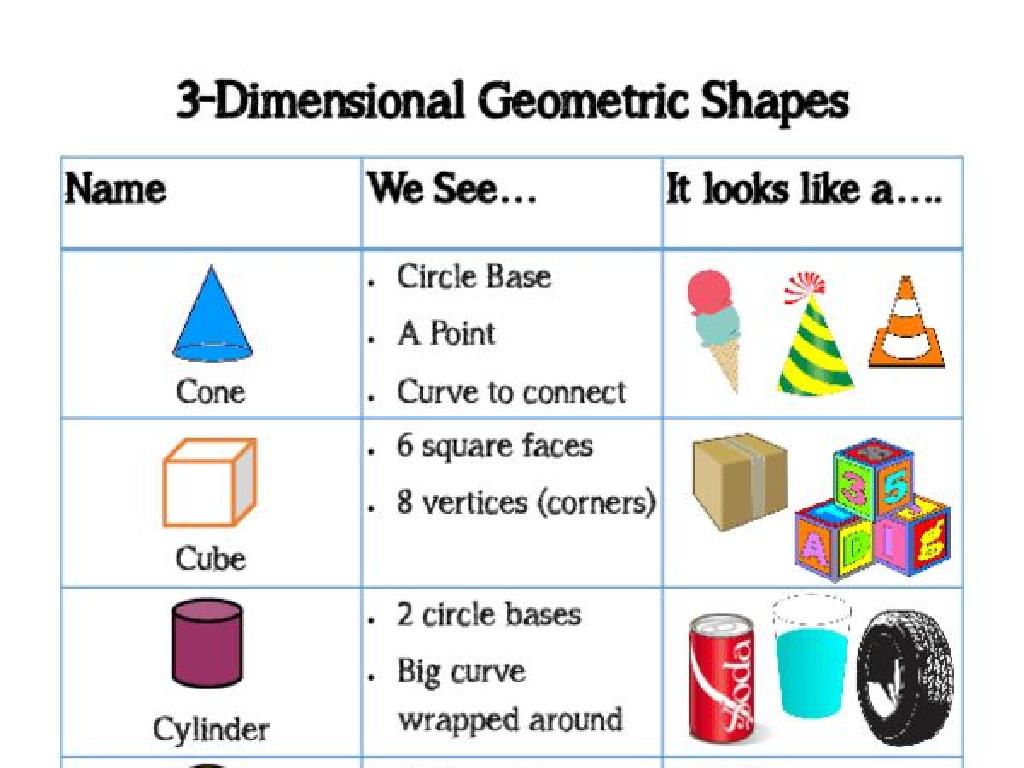Add Fractions With Unlike Denominators
Subject: Math
Grade: Fifth grade
Topic: Add And Subtract Fractions
Please LOG IN to download the presentation. Access is available to registered users only.
View More Content
Introduction to Adding Fractions
– Recap: What are fractions?
– Fractions represent parts of a whole, like 1/2 a pizza
– Adding fractions explained
– Combining fractions means combining parts
– Adding with different denominators
– Find a common denominator to add fractions like 1/3 + 1/4
– Importance of this skill
– Useful for real-life problems, like combining different liquid measures
|
Begin with a brief review of what fractions are, ensuring students recall that fractions represent parts of a whole. Explain that adding fractions is similar to combining parts of two or more wholes, such as two different pizza slices. Emphasize the need for a common denominator when adding fractions with unlike denominators, as it’s like making sure the pieces are the same size before combining them. Highlight the importance of this skill in real-life situations, such as cooking or mixing liquids, where measurements often need to be combined. This foundational understanding will set the stage for learning the methods to find common denominators and perform the addition.
Understanding Denominators in Fractions
– What is a denominator?
– The bottom number of a fraction, showing total parts
– Comparing same and unlike denominators
– Same denominators: 1/4 + 2/4; Unlike: 1/3 + 1/4
– Examples with unlike denominators
– 1/2 + 1/3; 3/4 + 2/5. How can we add these?
– Practice finding common denominators
– To add fractions with unlike denominators, find a common denominator
|
This slide introduces the concept of denominators, a foundational element in understanding fractions. Begin by explaining that a denominator represents the total number of equal parts into which something is divided. Highlight the difference between adding fractions with the same denominators (easy addition) versus unlike denominators (requires extra steps). Provide clear examples of unlike denominators to illustrate the concept. Finally, guide students on how to find a common denominator as a precursor to adding fractions with unlike denominators. Encourage students to practice this skill with various examples and ensure they understand the process before moving on.
Making Denominators Alike
– Find the Least Common Denominator (LCD)
– LCD is the smallest number that both denominators can divide into.
– Use multiplication for common denominators
– Multiply the numerators and denominators to get the same denominators.
– Practice: LCD for 1/3 and 1/4
– What’s the smallest number that 3 and 4 both divide into? Multiply to match this number.
|
This slide introduces the concept of finding a common denominator when adding fractions with unlike denominators. Start by explaining the Least Common Denominator (LCD) as the smallest number that both original denominators can divide into without a remainder. Demonstrate how to use multiplication to make the denominators the same. For the practice example, guide students to find the LCD of 1/3 and 1/4, which is 12. Show them how to multiply both the numerator and denominator of each fraction to get equivalent fractions with the LCD as the new denominator. Encourage students to work through this process step by step and verify their answers with a partner.
Adding Fractions with Unlike Denominators
– Understand adding fractions
– Find a common denominator, then add numerators.
– Example: Add 1/3 and 1/4
– Common denominator for 1/3 and 1/4 is 12. So, 1/3 becomes 4/12 and 1/4 becomes 3/12. Add to get 7/12.
– Simplify to check your work
– Ensure the fraction is in simplest form. 7/12 is already simplified.
|
This slide introduces the concept of adding fractions with unlike denominators. Start by explaining the need for a common denominator to add fractions effectively. Use the example of adding 1/3 and 1/4 to illustrate finding a common denominator and converting the fractions before adding. After adding the fractions, emphasize the importance of simplification to check the work. The example provided does not require further simplification, but students should always look to simplify their answers. Encourage students to practice with additional examples and to always verify their answers through simplification.
Adding Fractions with Unlike Denominators
– Example 1: Add 2/5 and 3/8
– Find a common denominator, then add: 2/5 + 3/8 = 16/40 + 15/40 = 31/40
– Example 2: Add 7/6 and 1/2
– Simplify if needed: 7/6 + 1/2 = 7/6 + 3/6 = 10/6 = 1 2/3
|
This slide is designed for a class activity where students will practice adding fractions with unlike denominators. Begin by walking through the steps of finding a common denominator and rewriting each fraction. For Example 1, show how to convert 2/5 and 3/8 to have a common denominator of 40, then add the numerators. For Example 2, demonstrate how to convert 1/2 to have the same denominator as 7/6, add the numerators, and then simplify the fraction. Encourage students to work through these examples in pairs or small groups, and then discuss as a class. Provide additional problems for students who finish early or need extra practice.
Class Activity: Fraction Addition Race
– Team up for fraction problems
– Solve fractions with different denominators
– Find a common denominator, then add
– Each team presents their solutions
– Explain your strategy to the class
– Prizes for the winning team
– Encouragement boosts motivation and learning
|
This activity is designed to promote teamwork and reinforce the concept of adding fractions with unlike denominators. Divide the class into small groups and provide each with a set of fraction addition problems. Guide them to find a common denominator before adding. After solving, each group will explain their problem-solving approach to the class, enhancing their understanding and communication skills. The competitive element with prizes should encourage engagement and excitement. Prepare a variety of problems with varying difficulty levels to cater to all students. Possible activities include creating visual aids, using fraction strips, or drawing pie charts to represent the fractions being added.
Wrapping Up: Adding Fractions with Unlike Denominators
– Review of fraction addition
– Practice makes perfect
– Consistent practice is key to mastering new math skills
– Homework: 10 fraction problems
– Solve problems to apply what you’ve learned today
– Bring questions next class
– Any difficulties? Write them down to discuss
|
As we conclude today’s lesson on adding fractions with unlike denominators, it’s crucial to emphasize the importance of practice. Homework has been assigned to reinforce the concepts learned in class. The 10 problems will cover a range of difficulties to ensure students apply the steps of finding a common denominator and adding numerators correctly. Remind students to attempt all problems and bring any questions they have to the next class for clarification. This will help identify areas where they may need further explanation or assistance.






